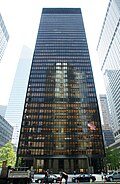International Style (architecture)
The International Style or internationalism is a major architectural style that was created in the 1920s and 1930s. It is similar to modernism and modern architecture. It was first named by Museum of Modern Art curators Henry-Russell Hitchcock and Philip Johnson in 1932.[1][2][3][4]
International Style (architecture) Media
Kiefhoek Worker's Housing project, now a Museum, Rotterdam, by Jacobus Oud (1930)
The Weissenhof Estate, Stuttgart, Germany (1927)
Philip Johnson co-defined the International Style with Henry-Russell Hitchcock as a young college graduate, and later became one of its practitioners.
The Glass Palace, Heerlen, Netherlands, Frits Peutz (1935).
Dizengoff Circle, White City, Tel Aviv, by Genia Averbuch, 1934
The Kavanagh Building in Buenos Aires, by Sánchez, Lagos & de la Torre (1936).
Seagram Building, New York, Ludwig Mies van der Rohe (1958)
Tower C of Place de Ville
References
- ↑ Khan, Hasan-Uddin (2009). El Estilo Internacional (in español). Köln: Taschen. p. 7-11. ISBN 9783836510530.
- ↑ Turner, Jane (1996). The Dictionary of Art. 26 Raphon to Rome, ancient, §II: Architecture. London: Grove. p. 14. ISBN 1-884446-00-0.
- ↑ Poletti, Federico (2006). El siglo XX. Vanguardias (in español). Milan: Electa. p. 101. ISBN 84-8156-404-4.
- ↑ Baldellou, Miguel Ángel; Capitel, Antón (1995). Summa Artis XL: Arquitectura española del siglo XX (in español). Madrid: Espasa Calpe. p. 13. ISBN 84-239-5482-X.








